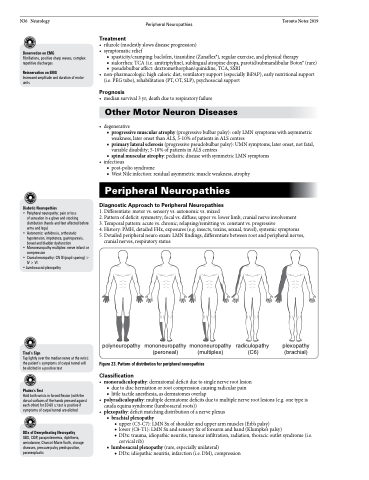Page 778 - TNFlipTest
P. 778
N36 Neurology
Peripheral Neuropathies Toronto Notes 2019
Denervation on EMG
Fibrillations, positive sharp waves, complex repetitive discharges
Reinnervation on EMG
Increased amplitude and duration of motor units
Treatment
• riluzole(modestlyslowsdiseaseprogression) • symptomaticrelief
■ spasticity/cramping: baclofen, tizanidine (Zanaflex®), regular exercise, and physical therapy
■ sialorrhea: TCA (i.e. amitriptyline), sublingual atropine drops, parotid/submandibular Botox® (rare) ■ pseudobulbar affect: dextromethorphan/quinidine, TCA, SSRI
• non-pharmacologic:highcaloricdiet,ventilatorysupport(especiallyBiPAP),earlynutritionalsupport (i.e. PEG tube), rehabilitation (PT, OT, SLP), psychosocial support
Prognosis
• mediansurvival3yr;deathduetorespiratoryfailure
Other Motor Neuron Diseases
• degenerative
■ progressivemuscularatrophy(progressivebulbarpalsy):onlyLMNsymptomswithasymmetric
weakness, later onset than ALS, 5-10% of patients in ALS centres
■ primary lateral sclerosis (progressive pseudobulbar palsy): UMN symptoms, later onset, not fatal,
variable disability; 5-10% of patients in ALS centres
■ spinalmuscularatrophy:pediatricdiseasewithsymmetricLMNsymptoms
• infectious
■ post-polio syndrome
■ West Nile infection: residual asymmetric muscle weakness, atrophy
Peripheral Neuropathies
Diagnostic Approach to Peripheral Neuropathies
1. Differentiate: motor vs. sensory vs. autonomic vs. mixed
2. Pattern of deficit: symmetry; focal vs. diffuse; upper vs. lower limb; cranial nerve involvement
3. Temporal pattern: acute vs. chronic; relapsing/remitting vs. constant vs. progressive
4. History: PMH, detailed FHx, exposures (e.g. insects, toxins, sexual, travel), systemic symptoms
5. Detailed peripheral neuro exam: LMN findings, differentiate between root and peripheral nerves,
Diabetic Neuropathies
• Peripheral neuropathy: pain or loss
of sensation in a glove and stocking distribution (hands and feet affected before arms and legs)
• Autonomic: anhidrosis, orthostatic hypotension, impotence, gastroparesis, bowel and bladder dysfunction
• Mononeuropathy multiplex: nerve infarct or compression
• Cranial neuropathy: CN III (pupil sparing) > IV>VI
• Lumbosacral plexopathy
cranial nerves, respiratory status
Tinel’s Sign
Tap lightly over the median nerve at the wrist; the patient’s symptoms of carpal tunnel will be elicited in a positive test
Phalen’s Test
Hold both wrists in forced flexion (with the dorsal surfaces of the hands pressed against each other) for 30-60 s; test is positive if symptoms of carpal tunnel are elicited
DDx of Demyelinating Neuropathy
GBS, CIDP, paraproteinemia, diphtheria, amiodarone, Charcot-Marie-Tooth, storage diseases,pressurepalsypredisposition, paraneoplastic
polyneuropathy mononeuropathy mononeuropathy radiculopathy (peroneal) (multiplex) (C6)
Figure 23. Pattern of distribution for peripheral neuropathies
Classification
• monoradiculopathy:dermatomaldeficitduetosinglenerverootlesion ■ due to disc herniation or root compression causing radicular pain
■ little tactile anesthesia, as dermatomes overlap
plexopathy (brachial)
• polyradiculopathy: multiple dermatome deficits due to multiple nerve root lesions (e.g. one type is cauda equina syndrome (lumbosacral roots))
• plexopathy:deficitmatchingdistributionofanerveplexus ■ brachial plexopathy
◆ upper (C5-C7): LMN Sx of shoulder and upper arm muscles (Erb’s palsy)
◆ lower (C8-T1): LMN Sx and sensory Sx of forearm and hand (Klumpke’s palsy)
◆ DDx: trauma, idiopathic neuritis, tumour infiltration, radiation, thoracic outlet syndrome (i.e.
cervical rib)
■ lumbosacralplexopathy(rare,especiallyunilateral)
◆ DDx: idiopathic neuritis, infarction (i.e. DM), compression


